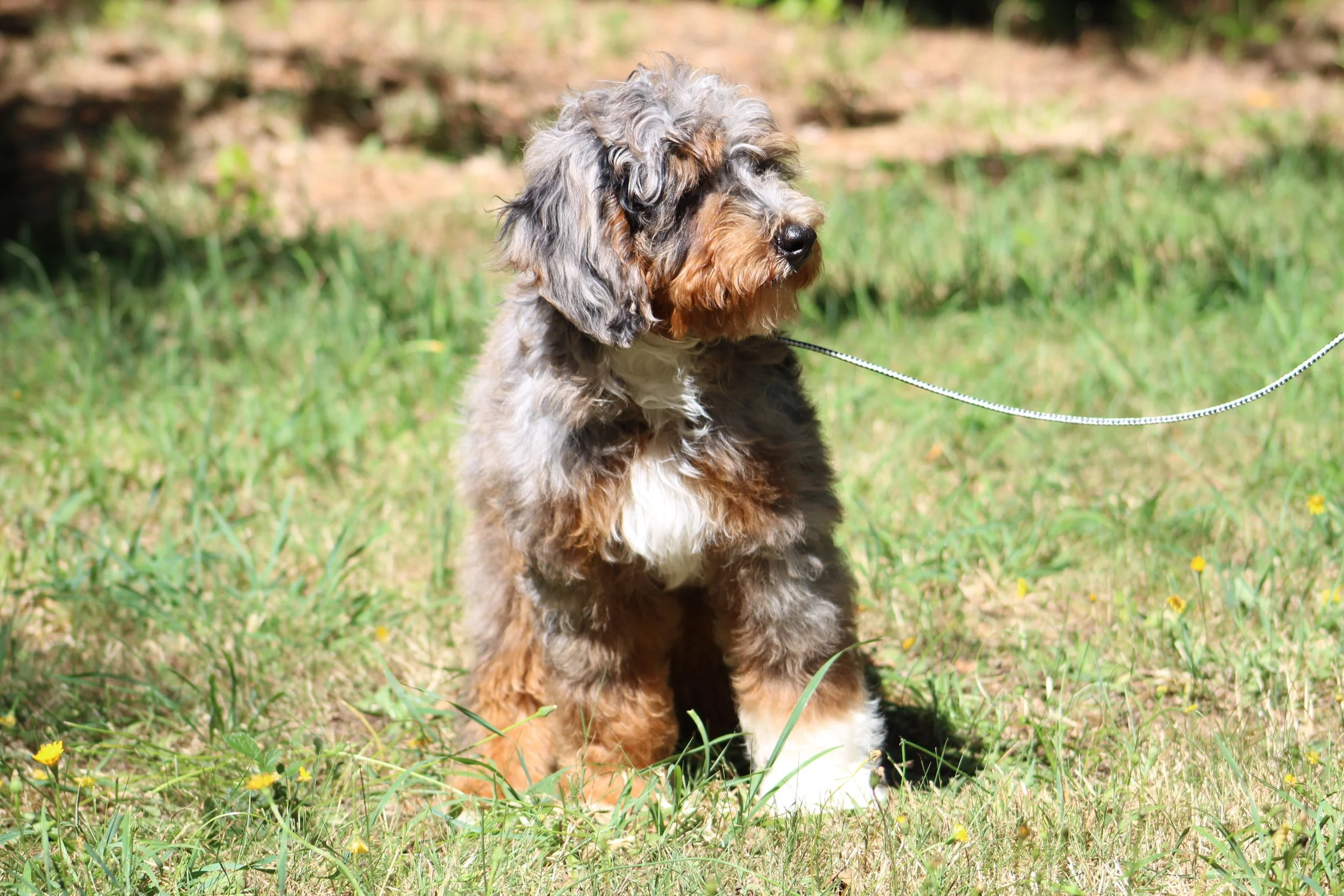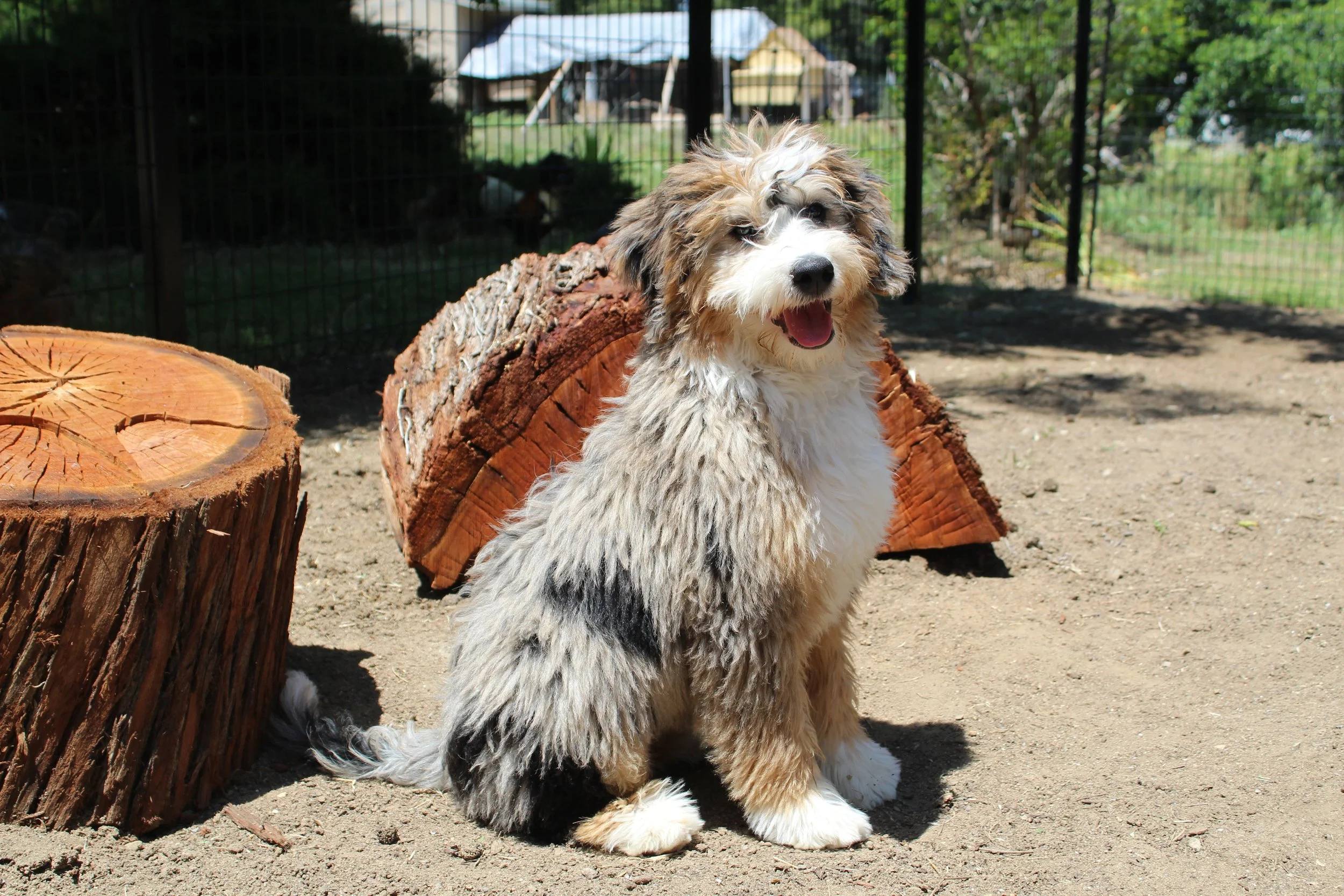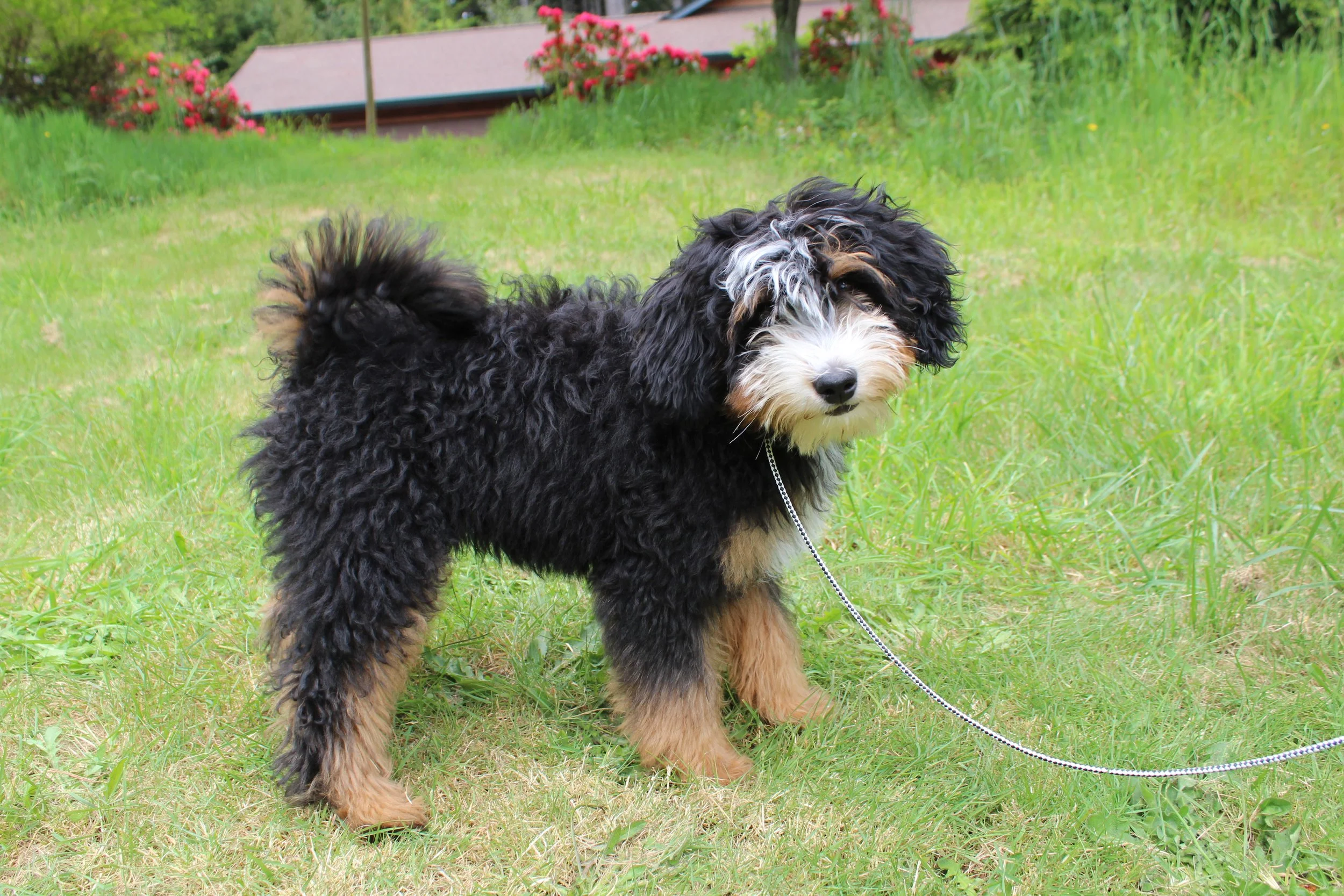
About Bernedoodles
Doodles…they will steal your heart and then your socks.
What is a Bernedoodle?
A Bernedoodle is a type of Doodle hybrid and includes two breeds: Bernese Mountain Dog and Poodle.
What is a Doodle?
A Doodle is a cross between a Poodle and another dog breed. The Oodles part of the name is a way to refer to the Poodle part of the mix (Bernedoodles, Aussiedoodles etc.). Sometimes they are also referred to as Poos (Cavapoo, Cockapoo etc.). They are purposely bred to combine the positive characteristics of two or more recognized breeds. The goal is to “better the breed” and select for the traits, confirmation, intelligence, temperament, coat and hypo-allergenic qualities that will make an ideal family companion.
What is an Australian Bernedoodle?
An Australian Bernedoodle is a combination of an Australian Labradoodle, Bernese Mountain Dog & Poodle). The Australian Labradoodle is comprised of 6 breeds - the Poodle, Labrador Retriever, Irish Water Spaniel, Curly Coat Retriever, American Cocker Spaniel and English Cocker Spaniel) so you can have any of these 8 breeds as well as Bernese and Poodle in this mix.
Note: we do not breed this mix for a variety of reasons.
Which Breeds Do We Have at Blue Skye Doodles?
We currently focus on Bernedoodles (BD’s) and Aussie Bernedoodles (Australian Mtn. Doodles) for their intelligence, loyalty, eagerness to learn and good-natured personalities which makes them wonderful family dogs as well as service and therapy dogs. We began our breeding program with our foundation dogs Ryver (our Aussiedoodle) and Skye (our Bernedoodle) in late 2015. To my knowledge we were the first to do the Australian Mountain Doodle cross and we originally called them Aussie Bernedoodles. As they have grown in popularity, they have also become known as Australian Mountain Doodles.
Whichever one you choose, your new doodle will have the best start in life and is sure to be a beloved friend and family member. Like Reese’s Pieces, most people can’t stop at just one.
How Big Do Bernedoodles Get?
Micro Mini Bernedoodles range from 10-24 lbs
Mini Bernedoodles range from 25-39 lbs
Medium Bernedoodles range from 40-54 lbs
Standard Bernedoodles will be 55 lbs or larger
What Size Bernedoodles Do We Breed?
Blue Skye Doodle Bernedoodles are typically in the mini range of 25-39 lbs. and the higher end of micro mini range. Our most common size range is going to be 20-35 lbs. and we don’t typically produce puppies below 18 lbs.
Note: Since Bernese Mountain Dogs weigh between 70 and 125 lbs, we do not do the F1 (first generation) pairing. When purchasing an F1 from another breeder be aware that there will likely be huge variations in the adult size of those puppies. We use multi-generational parents, so there is a longer history of smaller sizes and less variability in the adult size within our litters.
Why Do We Breed This Size?
We have a strong preference for the 25 to 39 lb size for a variety of reasons.
They are not too big. Under 40 lbs is a comfortable size in case you need to pick them up, carry them to a car or put them in a tub or on a grooming table. They tend to have fewer hip and joint issues than larger sized dogs. They cost less to feed. Since veterinarians price some of their services based on a dog’s weight, you will often pay less for a dog in this size range. Groomers also charge more for larger dogs and some grooming shops and mobile groomers don’t have a bathing tub or grooming table sized for larger breeds which limits your options.
They are not too small. This size range is sturdy and appropriately large enough to be safe with children. They can jump into a car on their own and are less likely to injure themselves getting off of a sofa or bed. They aren’t prone to some of the issues commonly found in tiny dogs (weak bones/joints, yappiness, poor teeth alignment and more).
What is a “Mini Bernese Mountain Dog”?
So there is no such thing as a mini Bernese. A Bernese Mountain Dog typically weighs 80-115 lbs for males and 70-95 lbs for females. They are a large and sturdy breed whose strength and endurance was used to pull carts and do other tasks on Switzerland farms. A very small female would be around 65lbs so not really mini size. This is one of the reasons the Bernedoodle has risen in popularity. Responsible, selective breeding can consistently produce a mini to medium size, more appropriate for today’s families. Be cautious of breeders using a black tricolor King Charles Cavalier parent. Not only will you get a lot of inconsistency in size, but the Cavaliers are known to have a lot of health problems that will now be introduced into this pairing. Do Bernedoodles Shed?
Our BD’s will be low shedding. We carefully evaluate and genetically test our parents to ensure we are producing low shedding and low allergen puppies. Some puppies from specific pairings may have more or less low shedding/low allergen properties, so it is important to communicate your needs and preferences with us.
All dogs are different and this is true even with the amount of shedding. As is the case with many traits, the degree of shedding is not strictly regulated by a single gene, but rather by a combination of genes functioning together. Further research has identified a link between furnishings or improper coats (F locus) and shedding. Thus, understanding the dog’s furnishing genetics can help determine the dog’s overall degree of shedding. Dogs without furnishings (having a smooth muzzle with no beard) have a higher propensity to shed.
Regardless of coat, all dogs benefit from regular brushing and occasional visits to a professional groomer. Light-shedding dogs will leave some hairs behind, especially after just being brushed or bathed and you will see plenty of hair in the brush itself. But you will notice significantly less than from a regular coated dog. It can be difficult to determine how much a dog will shed until it is one year old. In general, the curly/fleece coats, are less likely to visibly shed as any loose hair tends to curl into itself.
Are Bernedoodles Hypo-Allergenic?
BD’s are typically hypoallergenic but NOT non-allergenic. Hypo-allergenic means having a decreased tendency to provoke an allergic response. No dog is 100% non-allergenic (meaning a dog that does not produce an allergic response). Most allergic responses to dogs are triggered by proteins in the dog's saliva and to a lesser degree their urine. So dog's that drool heavily or soil in the house are poor choices for people with allergies. These proteins end up in the dog's dander which then stick to the hair.
Some breeds carry a lot more of these allergy-triggering proteins on their hair than do others due to seborrheic levels rather than hair length. Seborrheic dogs produce more sebum which is the oily substance produced by the gland at the base of the hair follicle which lubricate and waterproof the hair.
High seborrheic dogs like Labrador Retrievers carry the highest levels of these proteins. Less oily haired breeds produce less dander. The Poodle is one of the least oily haired breeds which is why Poodles (and consequently Doodles) are more hypoallergenic and also have NO doggie odor.
Allergies are often caused by dander, the dead skin cells shed by all dogs and dog saliva, causing itching or hives when licked. People with mild allergies often find they can tolerate low shedding dogs who produce less dander and breeds which drool less frequently and have less oily (waterproof) coats.
Experienced doodle breeders know the genetics of the dam and sire and test for furnishings etc. so they can produce furnished puppies that will be the lowest allergen, lowest shedding possible.
What Type of Coats Do Bernedoodles Have?
BD coats can be straight, wavy or curly. The type of coat they have will depend upon the genes received from both their parents. Breeders can typically tell at birth if the puppy will have a curly coat or a straight/wavy coat. Confirming if the coat is genetically straight or wavy requires testing by a professional geneticist as they often look identical.
BD coats tend to be soft to the touch. They will require regular brushing and combing to keep knots from forming. The curly coat is considered to be the most low shedding and allergy friendly and is usually kept clipped fairly short. If you prefer the look of a shaggy Doodle but still need the lowest allergen coat, we will consider furnishings and coat genetics when making a recommendation for a puppy. Coats vary within the same litter and can change as they grow out their puppy coat and their adult coat comes in.
Having the right breeder matters. They should know the coat curl genetics of their parents and be able to direct you to a puppy with the right coat for your preferences.
What Generations of Bernedoodles Do We Breed?
We work almost exclusively with multi-generational parents in our program. That means our puppies are typically F3 or higher. We have done genetic coat and color testing on every parent, so we know what we are working with and what to expect. All puppies will have furnishings (the doodle beard).
An F1 generation is the “first” generation between a Poodle parent and another breed. It will almost always produce a puppy with one copy of furnishings (F/IC or F/f) and one copy of coat curl (-/+) resulting in a wavy coat and a fluffy Doodle face. An F1b is a first generation Doodle crossed “back” to one of the parent breeds, usually the Poodle side. This results in more puppies with two copies of furnishings (F/F), 3/4 of a litter of curly coats, and a much higher breed content of Poodle. It is better than the F1 generation in terms of being hypo-allergenic/low shedding. An F2 generations results when both parents are F1 Doodles. This pairing can produce un-furnished puppies and is not recommended.








